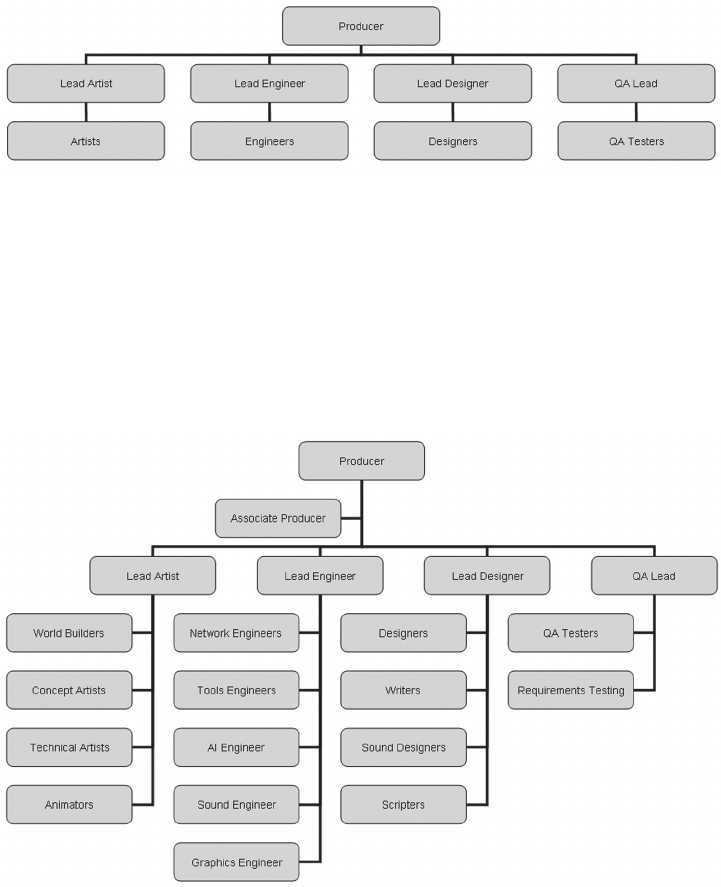
32 THE GAME PRODUCTION HANDBOOK, 2/E
instead of a design one. In some instances, the designer creates the level
designs on paper, and then an artist builds the levels.
Scripter: This person places the interactive objects and enemies in the lev-
els. Essentially, he controls how many enemies a player will face, where the
gameplay challenges appear in a level, and how non-player characters will
interact with the player’s character, and so on.
Writer
The writer is responsible for creating the story elements, characters, and dia-
logue for the game. The writer interacts closely with the lead designer and/or
creative director to ensure that these elements are in keeping with the game’s
creative vision. The writer also writes marketing and PR copy, website content,
the manual, and anything else that needs written related to the game. Writers
must have experience in writing for interactive media and creative writing.
Background and Training
As with producers, no clearly defined guidelines exist regarding the skills a de-
signer must possess. Designers come from a variety of backgrounds with no
standard job path. Designers need strong communication skills, both written
and verbal, because they must clearly communicate abstract creative concepts to
an entire team of people and guide these people in making these ideas concrete.
Designers are familiar with a variety of game theories and play many games.
Ultimately, they must be open-minded and have a sense of what the player finds
fun and entertaining.
DESIGN SKILLS
Clint Hocking, Creative Director
Ubisoft
Game design is such a new field that there isn’t really a specific path toward it.
You need to be able to see both the system design aspect and the experience design
aspect of the job. As far as I know there is no really effective way to receive training
in both of these things.
The best advice I can give to anyone who wants to be a game designer is to get
a broad education. Go to a good liberal arts school, or a good engineering school
where interdisciplinary study is emphasized. Get a degree in computer science
with a minor in fine art or the inverse. While you’re studying, work on games and
play games. Design pen and paper role playing games, board games, card games,

ROLES ON THE TEAM 33
web-based games or text-adventures, make an independent film to learn how to
work in disparate situations with small teams of people with diverse artistic and
technical talents—anything you can do to get a broad range of experience working
with both technical and creative people is going to be useful.
After doing a little bit of work in the mod community and releasing a level for
an Unreal mod called Strike Force, I got my start in the game industry as a level
designer on the first Splinter Cell. My level ended up being selected to go to E3,
where we received a lot of recognition, and my other level ended up being the OXM
demo level for the game.
During Splinter Cell’s development, the game designer left the project at the
Alpha deadline, and I was asked to take over for him. The writer also left the proj-
ect, and because I have a master’s degree in creative writing, and had been working
quite closely with the writer, I was asked to take over that job too. When we started
working on Splinter Cell: Chaos Theory, I took on the dual role of lead level de-
signer and scriptwriter. About halfway through, I also took on the role of creative
director. It’s been quite a roller coaster, and I’ve been very lucky to be in the right
place at the right time.
On development teams, the roles of the various designers depend upon and
are defined by their specific talents. I myself have been a level designer, a lead level
designer, a game designer, a writer/designer, a creative director… I have worked
with designers who are very methodical and process oriented, and designers who
are very creative, and some who are very technical.
Currently I am in pre-production as a creative director. I work directly with
the lead programmer, the producer, and the marketing manager. Underneath me
are the creative leads, the game designer, art director, lead level designer, writer,
etc. So at the high level the creative director has a lot of influence over the game
concept, and at the next tier, the game designer has as much influence as the other
creative leads. In smaller projects, the game designer might be equivalent to the
creative director.
A level designer is responsible for delivering a level, a scripter is responsible
for delivering working code, a writer/designer is responsible for delivering script.
‘Pure’ game designers might be responsible for working with focus test to deliver
focus-test reports and then communicating with level design about what the reports
mean, and then for delivering documentation that illustrates the follow-up plan to
the producer or creative director. Certain designers, like a creative director, lead
level designer, or game designer will be responsible for playing the game constantly
and delivering regular evaluations of the content, comments and criticism, and tasks
to the level designers so they can improve their levels.
Usually, the ‘most senior’ creative person on the project will have a lot of influ-
ence in the early stages. In the beginning there is a lot of freedom to be creative, but

34 THE GAME PRODUCTION HANDBOOK, 2/E
the further you move along, the less freedom you have and the more constraints you
adopt. Toward the end of the project, the creative lead has almost no say, and in the
last days before shipping, the lead programmer is the one who runs everything. In
a sense, ‘influence’ migrates from creative to technical over time at a pace dictated
by the producer.
As a general rule, the best designers—whether leads or not—all have one thing
in common. They are all able to see the systems, content, and experience (or what-
ever aspect of the design they are focused on) from the perspective of the player.
The best designers are able to let go of the specific direction they have for the
experience and design in such a way as to facilitate the player’s ability to express
himself in the interactive space. Unlike other creative fields where the creator has
a lot of authorial control over their creation, game designers do not create specific
experiences, they are enablers who create the possibility for people to engage in
a meaningful set of experiences. It’s difficult to understand this and let go of your
authorial control, but it’s critical to being a good designer.
2.6 QUALITY ASSURANCE TESTING
Quality assurance (QA) testers are a vital part of the game development process
and are involved in play testing and finding defects in the game. Testers usu-
ally begin their work in the production phase, after playable game builds are
available. They are involved in the development process until the end and are
often the last people to finish working on the game. Testers work closely with
all members of the development team and are a good resource for testing pro-
totypes and new features. The basic testing roles include the following:
■
Lead QA Tester
■
QA Tester
Lead QA Tester
The lead QA tester works closely with the producer and other leads on a project
to evaluate the game’s features from a testing point of view. For example, if the
game is going to feature 50 variables for creating a character, the lead QA tester
will estimate how long these variables will take to test and then most likely sug-
gest that the number be greatly reduced to save on testing time. This recommen-
dation might be because testing combinations of different variables can quickly
eat up valuable time, which is needed for testing other areas of the game. The
lead QA tester also determines, along with the producer and leads, when the
game is ready to be code released.
ROLES ON THE TEAM 35
The lead QA tester is responsible for writing the game’s test plan. To do this,
he must know exactly how every part of the game functions, so these details can
be included in the test plan. Finally, the lead QA tester manages all the testers
and assigns them specific areas of the test plan to check. A lead QA tester should
have two to three years of experience as a QA tester.
QA Tester
QA testers are responsible for checking the game’s functionality against the test
plan, testing new features and prototypes, and finding defects in the game soft-
ware. In addition, they check that the game meets all of the console manufacturer’s
technical requirements. They spend the majority of their work day actually play-
ing the game and, therefore, have informed opinions on the overall fun factor.
Background and Training
There is no formal training for a testing position. In general, testers are people
who enjoy playing games and have the ability to analyze problems and determine
their cause. Testers should have good written and oral communication skills so
they can clearly describe a bug to a developer. Lead testers should also have
good organizational and communication skills as they are responsible for manag-
ing a team of people.
The testing department is a good entry point into the field of game develop-
ment as testers are exposed to all aspects of game development. They also com-
municate directly with the developers on a daily basis.
2.7 TEAM ORGANIZATION
The team hierarchy can be organized in several ways, depending on the team
size and the roles to be filled. Small companies might have a single person fulfill-
ing multiple roles on a project, such as producer-lead designer, and large com-
panies might have a person with a single, clearly defined role, such as UI artist
or AI engineer. Whatever the team size, a clear hierarchy must be established so
people know with whom they need to talk to get information.
Figure 2.4 depicts a general organization chart for a typical small team with
a producer/lead structure. The producer manages the art, engineering, design,
and QA leads, and the leads manage the rest of the development team. With the
team organized in this fashion, it is still possible for a single person to fulfill mul-
tiple roles, even though it may cause some conflict. For example, Wade Tinney
is a producer/lead designer at Large Animal Games. He sometimes finds his
producer side disagreeing with his designer side, especially if it means adding
more time or money to the project.

36 THE GAME PRODUCTION HANDBOOK, 2/E
FIGURE 2.4 Small team with producer/lead structure.
Figure 2.5 is an organizational chart for a larger team. This structure still
follows the producer/lead model, but now specialized areas are evident in each
discipline. In a structure like this one, a network engineer reporting to the lead
may be in charge of several other network engineers. Also, an associate producer
is included on this team to assist the producer with the day-to-day management
of the production tasks.
FIGURE 2.5 Large team with producer/lead structure.
Figure 2.6 shows an organizational chart for a team headed up by an execu-
tive producer and directors in each discipline. This structure is likely to be more
common for larger development teams. With this particular structure, both
the producer and creative director report directly to the executive producer.
The producer is in charge of managing all the team personnel, and the creative
..................Content has been hidden....................
You can't read the all page of ebook, please click here login for view all page.
